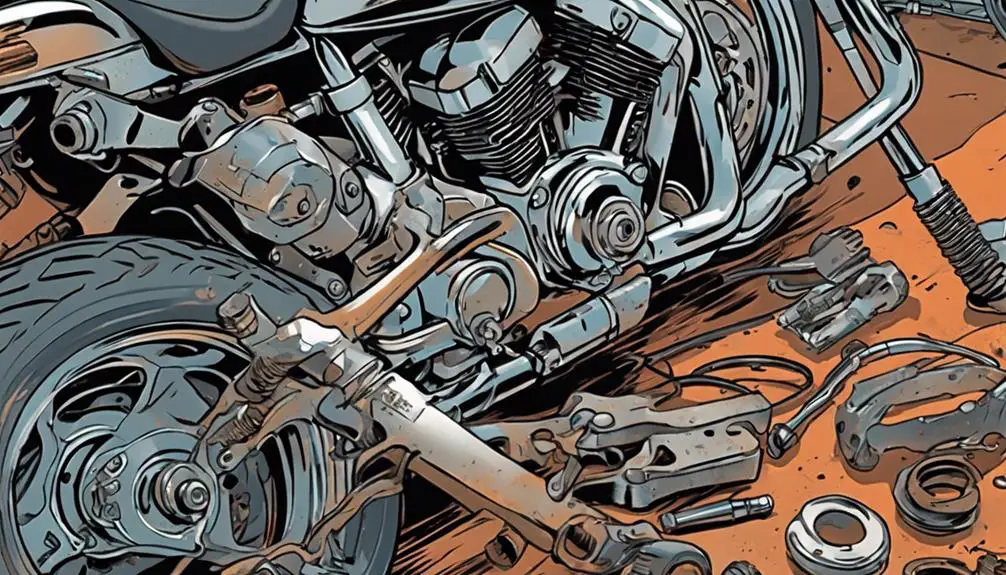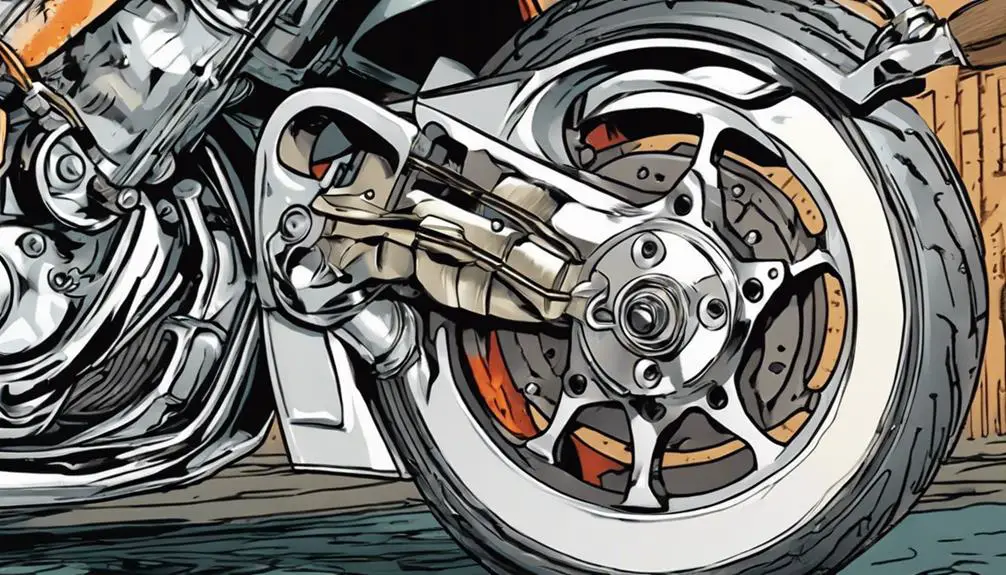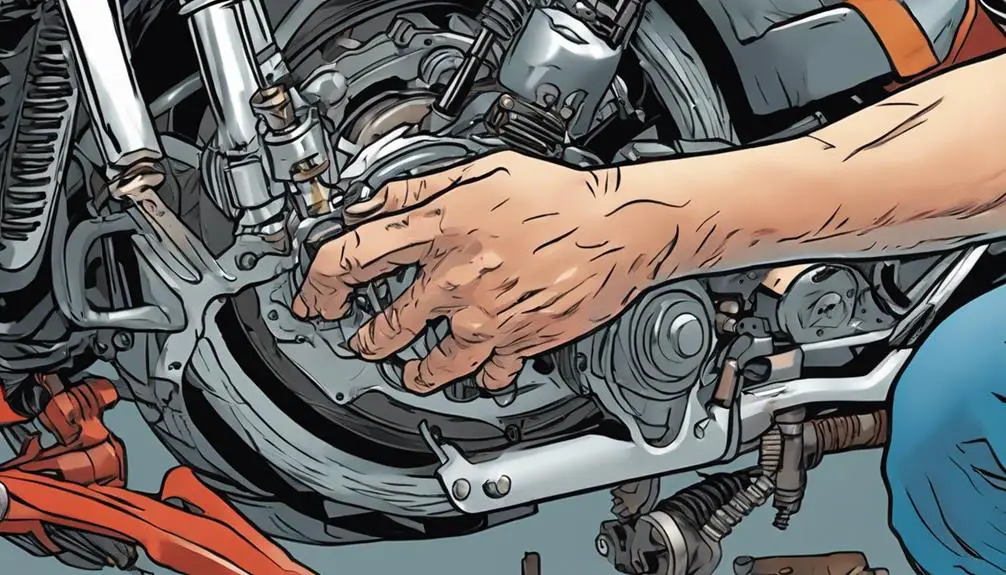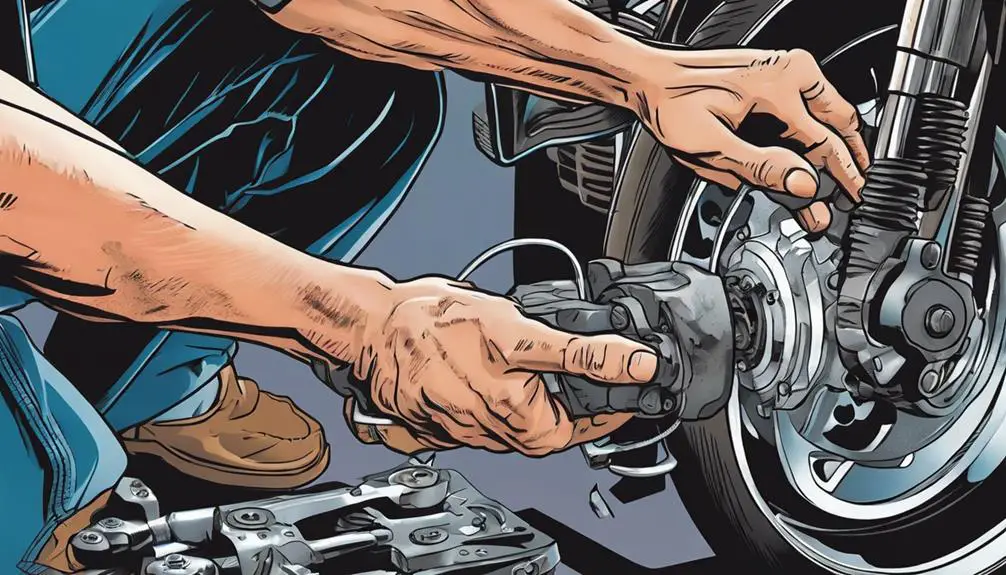Many riders underestimate the importance of regular brake maintenance, yet it can be the difference between a safe ride and an accident. You might not realize that worn brake pads can greatly impact your stopping power, leading to dangerous situations. Fortunately, there are straightforward steps you can take to address common brake issues before they escalate. From checking fluid levels to inspecting calipers, knowing how to tackle these problems can enhance your riding experience and safety. So, what are the key tips to keep your brakes in top shape?
Key Takeaways
- Regularly inspect brake pads for wear; replace if thickness is less than a quarter-inch to ensure effective braking performance.
- Check brake fluid levels and replace contaminated fluid to maintain optimal brake responsiveness and safety.
- Inspect brake lines for cracks or leaks; bleed the brakes if sponginess occurs to eliminate air trapped in the lines.
- Examine calipers for sticking components and ensure pistons move freely; clean with brake cleaner if necessary.
Inspecting Brake Pads

When inspecting brake pads, you should look for signs of wear, such as thinning material or uneven surfaces. Grab a flashlight and get up close; the details matter. If the pads are less than a quarter-inch thick, it's time to contemplate a replacement. You want your ride to feel liberating, not like a ticking time bomb.
Check for cracks or chunks missing, as these indicate that your pads are in trouble. Uneven wear suggests that something might be off with your braking system, so take note. You don't want to compromise your freedom on the road due to faulty brakes.
Also, listen for squeaking or grinding noises while you ride. These sounds are cries for help from your brake pads. Don't ignore them. If you feel vibrations when applying the brakes, that's another sign that your pads need attention.
Regularly inspecting your brake pads not only keeps you safe but also enhances your riding experience. Freedom comes from knowing your bike is in top shape, allowing you to conquer the open road with confidence. So, take a few moments to check those pads; your ride depends on it.
Checking Brake Fluid Levels
Checking your brake fluid levels is essential for maintaining ideal brake performance and guaranteeing your safety on the road. Low brake fluid can lead to reduced braking power, which is the last thing you want when you're cruising freely.
To check your brake fluid, start by locating the reservoir, usually found near the handlebars or under the seat. Once you've found it, inspect the fluid level against the marked indicators on the side of the reservoir. If it's below the recommended level, it's time to top it off with the correct type of brake fluid specified in your motorcycle's manual.
Don't mix different types of fluid, as that can lead to more problems down the line. While you're at it, look for any discoloration or contamination in the fluid. If it appears dark or murky, consider flushing and replacing it.
Keeping your brake fluid fresh not only guarantees peak performance but also enhances your riding experience. After all, the open road awaits—make sure you're ready to embrace it fully, knowing your brakes are in top condition.
Stay free, ride safe!
Diagnosing Brake Line Issues

After verifying your brake fluid levels are adequate, the next step is to diagnose any potential issues with your brake lines.
Start by visually inspecting the lines for any signs of wear, cracks, or leaks. If you spot any damage, it's essential to address it immediately. Even a small leak can lead to a loss of braking power, jeopardizing your freedom on the road.
Next, squeeze the brake lever and feel for any unusual softness or sponginess. This could indicate air trapped in the lines or a failing master cylinder. If your brake lever feels off, it's time to bleed the brakes, releasing any trapped air and restoring that crisp response.
Don't forget to check the fittings and connections as well. Loose or corroded fittings can create pressure issues, so make sure everything's tight and clean.
If you've examined all these areas and still face problems, it might be time to replace the brake lines entirely.
Prioritize your safety, and remember: a well-maintained brake system is a vital part of your ride. Keep your spirit free by confirming your bike is in excellent condition.
Evaluating Brake Caliper Function
To guarantee your brakes are performing at their best, inspect the brake calipers for signs of wear, corrosion, or sticking components. Start by ensuring the caliper's pistons move freely. If they're stuck, it could lead to uneven braking or reduced power. You can free them up by applying some brake cleaner and using a rubber mallet gently to tap the caliper.
Next, check the brake pads. Worn pads can affect caliper function, so replace them if they're too thin. Look for any uneven wear patterns; this might indicate a caliper issue that needs addressing.
Don't forget to examine the caliper mounting bolts, too—loose bolts can lead to misalignment and affect your stopping power.
Also, inspect the caliper seals. Cracked or damaged seals can lead to fluid leaks, compromising your braking performance. If you notice any leaks, it's essential to replace the seals or the entire caliper if necessary.
Maintaining Brake Rotors

Maintaining your brake rotors is essential for ensuring consistent stopping power and overall safety on your motorcycle. To start, regularly inspect your rotors for any signs of wear or warping. Look for grooves, discoloration, or cracks—these can signal that it's time for a replacement.
Next, keep your rotors clean. Debris, oil, or brake dust can interfere with braking performance. Use a dedicated brake cleaner to remove any contaminants, and make sure to wipe down the rotor surface with a clean cloth.
You should also pay attention to your brake pads. Worn pads can damage your rotors, so replace them when they start to show signs of excessive wear. Additionally, consider the type of riding you do; aggressive riding may require more frequent rotor maintenance.
Lastly, if you notice any unusual noises or vibrations when braking, don't ignore them. These could indicate rotor issues that need immediate attention. By staying proactive with your rotor maintenance, you'll not only enhance your ride but also embrace the freedom that comes with a well-functioning motorcycle. Your safety is worth it!
Troubleshooting ABS Faults
Identifying and troubleshooting ABS faults on your motorcycle is essential for ensuring ideal braking performance and overall safety.
Start by checking the ABS warning light on your dashboard. If it's illuminated, don't ignore it; this indicates a potential issue.
Next, listen for unusual sounds when you apply the brakes. Any grinding or clicking might signal a problem with the ABS module or sensors.
Inspect the ABS sensors, usually located near the brake calipers. Make sure they're clean and free from dirt or debris, as this can affect their function. If you notice any damaged wires or connectors, replace them right away.
A brake fluid leak can also cause ABS faults. Look for any signs of fluid around the brake lines and reservoir. If you spot a leak, fix it before it escalates into a more severe issue.
Addressing Brake Lever Problems

When you notice issues with your brake lever, the first step is to check the brake fluid level.
Low fluid can affect performance and may indicate a leak.
Next, inspect the lever adjustment settings to guarantee they're configured for peak control.
Check Brake Fluid Level
Checking the brake fluid level is essential for ensuring your motorcycle's brake lever functions properly. If the fluid is low, you might experience a spongy brake lever or reduced stopping power, which can compromise your freedom on the road.
Start by locating the brake fluid reservoir; it's usually near the handlebars or on the front brake caliper. Once you find it, take a look at the fluid level. Most reservoirs have markings indicating the minimum and maximum levels. If the fluid sits below the minimum line, it's time to top it up.
Use the recommended brake fluid for your bike—typically DOT 3 or DOT 4—found in your owner's manual. When adding brake fluid, avoid spilling it on your paint or plastic parts, as it can cause damage.
After topping up, check for leaks around the reservoir and brake lines. If you spot any, don't ignore them! Addressing leaks immediately can save you from more significant issues down the line.
Regularly checking your brake fluid level keeps your brakes responsive, ensuring that you can enjoy every ride with confidence and liberation.
Inspect Lever Adjustment Settings
Inspecting the lever adjustment settings is essential for guaranteeing your brake lever feels comfortable and responsive during your rides. The right lever position can make all the difference in your control and confidence on the road.
Start by checking the gap between the lever and your handlebar; you want it to be close enough for easy reach but not so tight that it hinders movement.
Adjust the lever to suit your grip preference. If it feels too far away or requires too much effort to pull, it's time for a tweak. Many bikes offer a simple adjustment mechanism right on the lever itself, allowing you to find that sweet spot quickly.
Don't forget to test the lever's responsiveness after making adjustments. Squeeze it gently to guarantee it engages smoothly without any sticking or excessive play.
Your liberation on two wheels depends on a reliable braking system.
Cleaning Brake Components
Keeping your brake components clean is essential for ideal performance and safety.
Regular cleaning helps prevent dirt and grime buildup, which can lead to serious issues.
We'll go over some recommended cleaning products to help you maintain your brakes effectively.
Importance of Regular Cleaning
Regularly cleaning your motorcycle's brake components is essential for ensuring best performance and safety on the road. Dirt, grime, and debris can accumulate over time, affecting the efficiency of your braking system. When you keep your brakes clean, you enhance their responsiveness and reduce the risk of failure when you need them most.
A clean braking system allows for smoother operation, providing you with the confidence to ride freely. When you eliminate contaminants, you're not just improving performance; you're also extending the lifespan of vital components like pads and rotors. This means less frequent replacements and more time enjoying the open road.
Moreover, regular cleaning helps you spot potential issues before they escalate. By taking a proactive approach, you empower yourself to address minor problems early, preventing costly repairs down the line. It's about embracing the journey with a sense of security, knowing your brakes are in top shape.
Recommended Cleaning Products
When it comes to cleaning your motorcycle's brake components, using the right products can make all the difference in maintaining their performance and longevity. Start with a quality brake cleaner that's specifically formulated to eliminate dust, oil, and grime without leaving harmful residues. Look for non-chlorinated options to avoid damaging rubber components.
Next, consider using a soft-bristle brush to reach into those tight spots around calipers and rotors. This'll help you dislodge stubborn dirt without scratching critical surfaces. For the brake pads, a gentle wipe with a microfiber cloth soaked in brake cleaner can keep them in top shape. Just remember to let them air dry to avoid any moisture issues.
Don't forget to check your brake fluid reservoir; a clean fluid keeps your system functioning smoothly. A fresh bottle of DOT fluid can be your ally here.
Replacing Worn Parts

Inspecting your motorcycle's brake components regularly helps you identify worn parts that need replacing before they compromise your safety.
When you notice squeaking, grinding, or a spongy feel in your brakes, it's time to take action. Brake pads are often the first to wear out, so check their thickness. If they're too thin, replace them. You don't want to risk your freedom on the open road with compromised stopping power.
Next, examine your brake rotors. Look for signs of warping, scoring, or excessive wear. If they're damaged, replacing them is essential for maintaining peak performance.
Don't forget to check your brake fluid; it can absorb moisture over time, leading to reduced effectiveness. If it's dark or contaminated, it's time for a flush and refill.
Seeking Professional Help
Sometimes, it's best to consult a professional mechanic to guarantee your motorcycle's brake system is functioning safely and efficiently. While you might be keen to tackle brake issues on your own, a trained eye can spot problems you might overlook. Mechanics have the experience and tools necessary to diagnose and fix complex brake issues effectively.
If you're feeling uncertain about your ability to fix a problem, don't hesitate to seek help. Ignoring brake issues can lead to dangerous situations on the road. A mechanic can assess your entire brake system—from the pads to the master cylinder—ensuring everything's in top shape.
Moreover, professional mechanics often provide valuable insights that can empower you in your motorcycle maintenance journey. They can educate you about preventative measures, helping you feel more liberated and confident in caring for your bike.
Frequently Asked Questions
How Often Should I Replace My Motorcycle Brake Pads?
You should replace your motorcycle brake pads when they wear down to about 1-2 millimeters. This usually happens after 20,000 to 30,000 miles, but it can vary based on your riding style and conditions.
Regularly check your pads for wear, and if you notice any squeaking or reduced stopping power, it's time to change them.
Staying on top of this keeps your ride safe and lets you enjoy the freedom of the open road.
Can Weather Affect My Motorcycle Brakes' Performance?
Did you know that nearly 40% of motorcycle accidents occur due to brake failure?
Weather can greatly impact your brakes' performance. Rain and moisture create slippery surfaces, making it harder to stop quickly. On the other hand, extreme heat can cause brake fade, reducing effectiveness.
Stay aware of these conditions; they can compromise your safety. Regularly check your brakes to verify they're ready, no matter what Mother Nature throws your way.
What Are Signs of Brake Overheating in Motorcycles?
When your motorcycle brakes overheat, you might notice several signs.
You'll feel a spongy or unresponsive brake lever, and the brakes may squeal or emit a burning smell.
If you experience a decrease in braking power or a vibration under your feet, take it seriously.
Check the brake fluid level and inspect the pads.
Recognizing these signs early is essential; it keeps you riding freely and safely on the open road.
How Do I Know if My Brake Lights Are Working?
Picture your motorcycle as a beacon, lighting the way for others.
To check if your brake lights are working, find a safe place and activate the brakes.
You can either have a friend watch the lights or position your bike near a reflective surface to see the glow.
If the lights shine bright, you're good to go!
If not, it's time to plunge into some troubleshooting and make certain your ride stays safe.
Is It Safe to Ride With Squeaky Brakes?
If you've got squeaky brakes, it's a sign that something's off.
While you might be tempted to ignore it, riding with squeaky brakes isn't safe. That noise often indicates wear or insufficient lubrication, which could lead to reduced stopping power.
You deserve a ride that's both thrilling and secure.
Conclusion
By staying proactive with your motorcycle's brake maintenance, you're not just ensuring your safety; you're also keeping the thrill of the ride alive.
Like a well-tuned engine, a reliable brake system is the heartbeat of your bike.
If you find any persistent issues, don't hesitate to seek professional help.
Remember, your brakes are your first line of defense on the road—treat them with care, and they'll reward you with confidence and control on every ride.